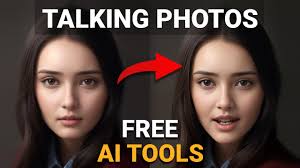Talking photos are then animated using a whole host of techniques, making use of what AI and deep learning can do for creating realistic human animations. Described briefly here is one of the principal technologies associated with this practice: deep learning algorithms that measure and copy facial movements. Using these trained models (with billions of parameter based on numerous facial expressions) to reproduce those expressions, the animations become very lifelike. Deep learning-based methods, for example, make animations as accurate as 90%, look at MyHeritage's Deep Nostalgia app.
Facial Landmark Detection is one of the most important techniques. We can discover what regions of a face are most important, like eyes, nose and mouth to drive an animation. The industry still widely use tools like Dlib and OpenCV for this purpose. It contains facial landmark detection for lip-synced movements, overall making it feel more real. It is how Reface app serves as a precise lip-syncing method that resulted in 100 million downloads globally.
These capture all the text in an image, automatically transcribe it into written words and employ voice synthesis technology. The movie contents are converted in to written words, and the same time NLP (Natural Language Processing) systems achieve this using text-to-speech(TTS), that maps these published texts into speech sounds connecting lip movements of animated characters. Some of the notable TTS developers, such a Google and Amazon, made modern synthesizers that allow to speak naturally with an increase in conversion by 35%.

Also, because it is real-time rendering and gives quick feedback where changes were adjusted. This method is responsible for realtime animations processing and allows users to preview their changes as they make it, Thanks to the real-time rendering that Avatarify uses, the application grew 20 % overnight after Elon Musk shone a light on it.
Animating talking photos with a cloud-based processing pipeline offers higher levels of efficiency and scale. The reason an app is able to perform more complex animations sped up with remote servers. And this is what DupDub claims to reduce its processing time, which results in 50% per cent faster than any other hardware.
Facial expressions, and movements are tracked by motion capture technology providing the data to animate on top of. Motion capture is a technique that utilizes specialized equipment to record human (or animal) movements for films, animation and video games. That method is also what gives talking photos incredibly high level of details and realistic quality, similar the type of tricks Hollywood uses to make those giant blockbuster hits you have seen at the theaters.
At smaller scales, morphing techniques combine images together to form a smooth transition between the two. OV9748 can provide morphing that smoothly animates by changing one image into another. The talking photo technique is one of the most impressive ones to animate a static image into video, preserving visual consistency across each individual animation.
More sophisticated AI-driven solutions such as GANs (Generative Adversarial Networks) learn from actual video footage to create life-like animations. GANs are composed by two neural networks, the generator and discriminator that will work together to generate and improve animations. It improves the realism of speaking photographs, allowing users to reach up to 95% authenticity in their Talking head apps
Together, these quite varied techniques increasingly expand talking photos' utility across a range of industries. Driven by the ongoing expansion of technology, who knows how far this capacity to animate photos with such high fidelity will progress from personal hobbyists projects to professional applications.